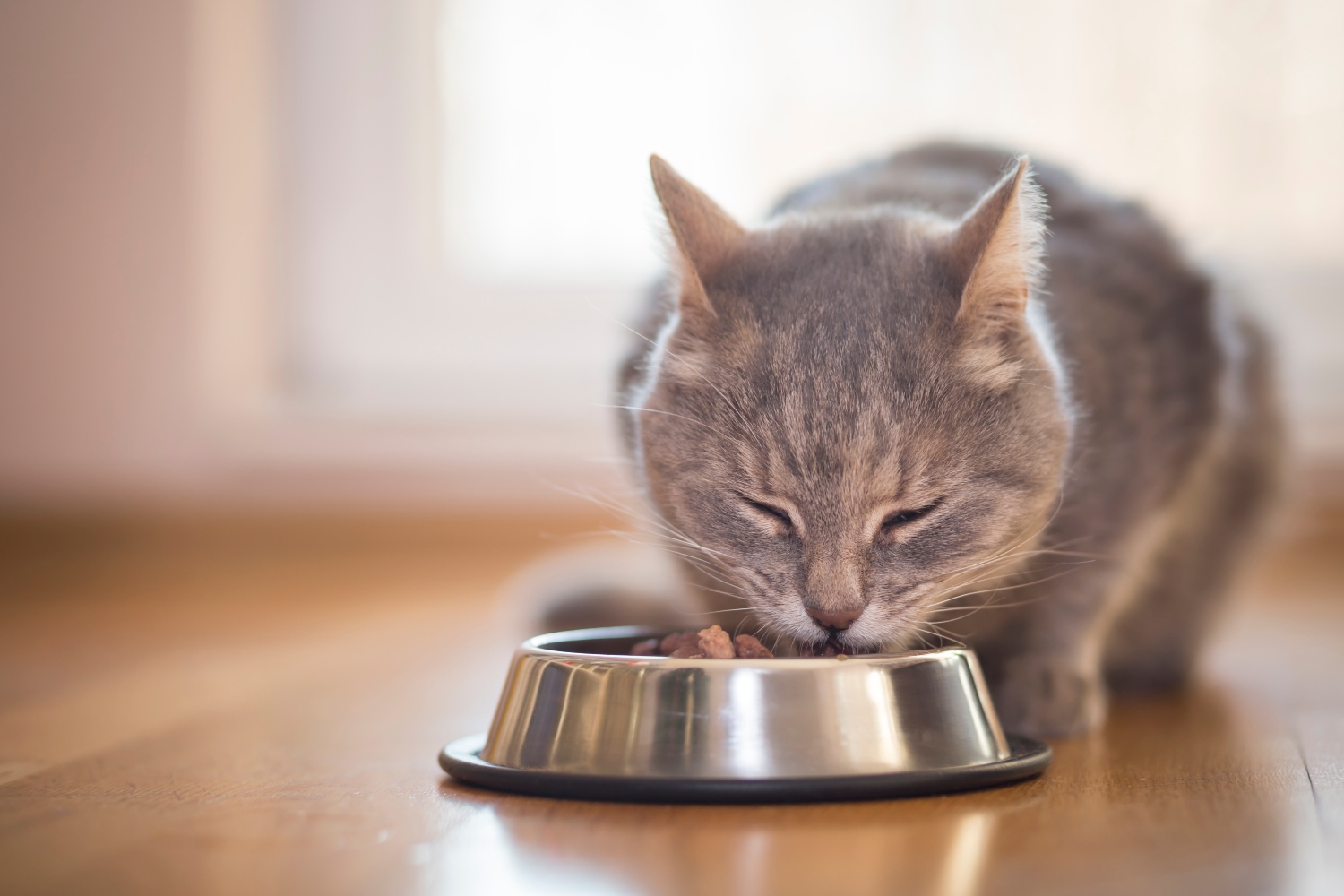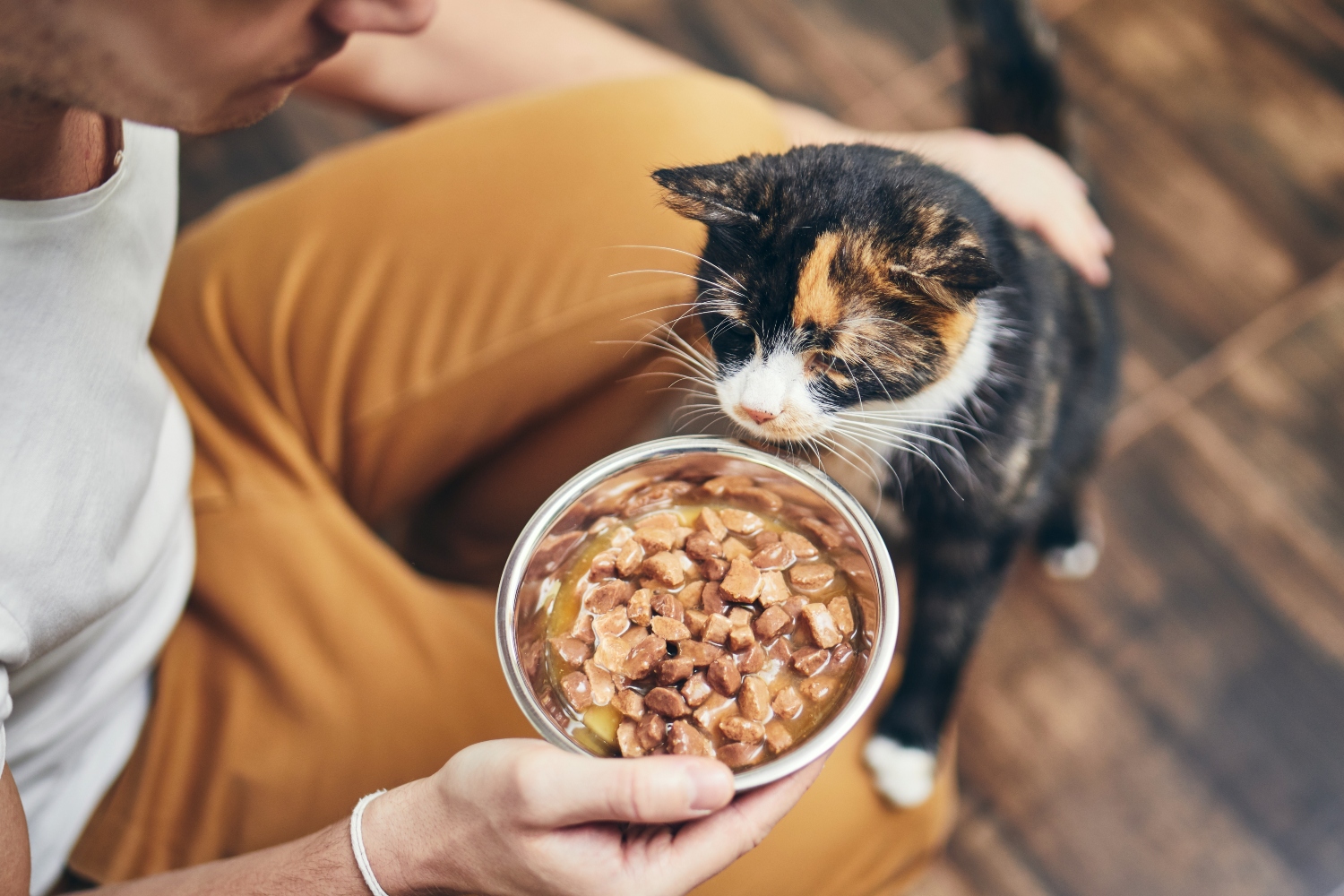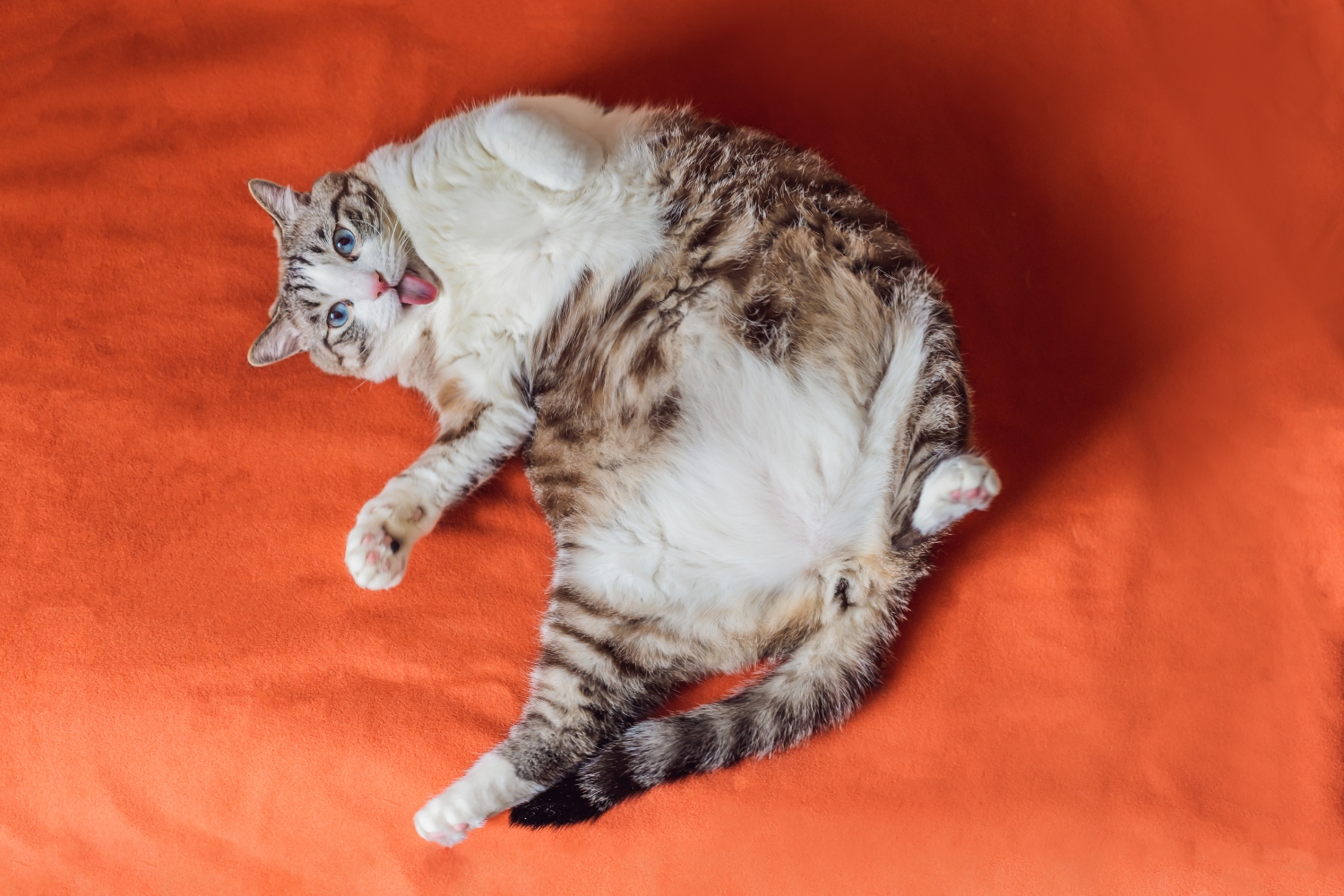
How much should I feed my senior cat?
17th February, 2023
Is your cat looking chubbier than usual? Being overweight can cause a number of health issues for your favourite feline. Help them stay slim with these top tips.
Has your older cat stopped going out as much as they used to? Do they like to lounge around inside rather than roam the neighbourhood? If your feline has cut down on their activity, you might need to cut down on their food. You should always aim to keep your cat at a healthy weight, especially when they’re getting on in years.
In this article, we’ll look at the type of foods that are suitable for older cats, how much you should feed them and what to do if they’ve gone off their food altogether.
Alongside dietary changes you’ll also need cat insurance for older cats to protect them into later life. Give our team a call today to get your ageing feline protected.
What should I feed my older cat?
Your cat has probably eaten the same thing for years without any issues, right? So why rock the boat? Well, just like us, cats tend to pile on the pounds in later life as they become less active. And that puts them at higher risk of all sorts of health problems.
As a responsible pet parent, you’ll want to provide them with the right amount of high quality, tasty food. But getting the right balance of protein and key nutrients is sometimes easier said than done.
The best thing to do is to gradually move them onto a specially formulated senior cat food. And we mean gradually. There are plenty of options available in pet food stores, but if you’re unsure of which one to choose, then your vet should be able to help.
In fact, it’s always a good idea to get the opinion of your vet before changing your cat’s diet. After all, your senior feline may have an underlying health condition that might be affected by nutritional changes.
What’s so great about senior cat food?
Not all senior cat foods are created equal, and what works for one particular cat’s needs might not work for yours. Just like finding the perfect cat insurance for older cats, there really isn’t a one-size-fits-all solution.
Specialist pet foods come with a host of benefits. These include:
- High fatty acids, zinc and linoleic acid help to maintain a healthy coat.
- Multivitamins help to keep their brain functioning normally.
- Added vitamin E boosts their immune system to fight diseases and infections.
- Extra taurine can help your cat’s vision and heart.
- Glucosamine and chondroitin help support their joints.
- Antioxidants like lycopene and Omega 3 help to strengthen their immune system and support body functions.
- Lower phosphorus and sodium help to prevent damage to vital organs such as the liver and kidneys.
- Prebiotics aid healthy digestion.
- Soft kibble is specially designed to protect a senior cat’s brittle teeth.
- It comes with fewer calories and less protein than regular adult cat food. This should mean your cat will still maintain their optimum body weight even as their activity levels drop.
However, reducing some ingredients should never be at the expense of smell and flavour. As cats age their senses can sometimes fade and they might become a ’fussy’ eater. To ensure they still get as much pleasure out of meal times as when they were a bouncy kitten, senior food might have a higher meat content to make it even more appealing.
The best senior cat foods recommended by veterinary professionals will be carefully designed to give your older cat the right levels of nutrients. If you’re worried about the cost of such foods, our cat insurance for older cats includes a senior food contribution.
Unfortunately, the older our cats get, the more likely it is they’ll develop a serious health condition. While some illnesses are treatable with medication, some are also treated with a change of diet.
Many older felines need so-called prescription diets in order to manage their health. While you can buy these foods without a vet prescription, we recommend they should only be used if advised by a vet.
A vet might recommend the following diets for your senior cat:
- Renal and kidney care diets
If your cat has been diagnosed with renal disease or kidney problems then you’ll want a high quality food that’s not only delicious but will also support kidney function and reduce the build-up of toxins in the body. - Gastrointestinal diets
Some older cats will have sensitive stomachs and find it difficult to digest some ingredients found in regular cat food. This may be a reason for your cat being bloated. Available in a wide range of flavours these are specially developed to promote firm stools and help with food tolerance. - Urinary diets
Cats can be prone to a range of uncomfortable urinary problems including feline lower urinary tract disease (FLUTD), stress-related cystitis, urinary infections and the development of urinary crystals or stones in their pee. A specialist diet that promotes urinary tract health could be the answer.
How much should you feed them?
Every cat is different and the exact amount of food you give them will depend on the type of food, cat’s breed, lifestyle and their body size. The most important thing is to feed your cat enough to keep them in a healthy condition.
Pet food specialists Whiskas also note that rather than changing the amount you feed them, you should change the type of food to one that better suits their age. Cat’s love routine, so suddenly cutting their food down significantly could result in both an upset cat and an upset owner.
Fortunately, when it comes to feeding older cats, there’s always help at hand. Your first port of call is to refer to the feeding guide on the back of the food packaging.
This will give you a decent estimate of how much of that food to give them. Although you might have to tweak the precise amounts to take account of your own individual cat’s needs.
Whiskas says a healthy and active adult cat needs around 240 calories per day, which can be obtained from a mixture of both dry and wet foods.
Using Purina’s Go-Cat Crunchy and Tender Senior Chicken Dry Cat Food as an example, the table below gives you an idea of the average amount you should be feeding a moderately active cat at normal environmental temperatures. Obviously, in individual cases, your cat may need more or less food.
| Weight of the cat in kilograms | Daily portion of dry food in grams |
| Up to 3 | 40 |
| 3 to 4 | 65 |
| 4 to 5 | 85 |
In terms of feeding your senior cat wet food, the amounts will differ as dry food is more energy rich. For example, using Whiskas Senior 7+ Poultry Feasts Wet Cat Food the table below shows you the amount an average cat would be fed.
| Weight of the cat in kilograms | Daily portion of wet food (85g pouches) |
| Up to 3 | 3 - 3.5 |
| 3 to 4 | 3.5 - 4 |
| 4 to 5 | 4 - 4.5 |
Whatever age your cat is, it’s vital to regularly weigh your feline friend. If they start to tip the scales, you’ll know that something needs to be done.
While a cat’s weight will fluctuate depending on the time of year, any substantial changes need to be investigated. Both sudden weight loss and sudden weight gain can be early signs of illness or disease and should be kept under close observation by your vet.
If you have cat insurance for older cats through Petwise, just arrange a vet video call. Our professionals are on hand 24/7 to answer your pet-related queries.
Another thing to watch out for – cats can get more affectionate as they get older. This might be great news for us owners but be careful to take any extra treats you’re feeding them into account in your daily food calculations.
Signs it might be time to switch to senior cat food

So, when is it time to switch your beloved cat from regular adult cat food to senior cat food? As you’d expect, that will vary depending on the individual cat.
Generally, vets recommend cats will begin switching to senior food around the age of 7. However, some felines may be able to stick with their old cat food until they’re 8-10 years old. Others may need to make the change sooner.
It really depends on the cat and their overall health. Signs it might be time to switch include:
- Weight gain – If your cat looks visibly bigger, it might be time to switch.
- Dental problems – Chewing hard kibble can become really tricky for older cats.
- Becoming less active – Older cats need food with lower levels of protein and fat.
- Changes in drinking and peeing habits – A common sign that your older cat is beginning to develop kidney or urinary tract issues.
Before switching your cat to a senior food diet, speak with your vet about your cat's specific needs and any health issues they may have. Any of the changes mentioned above could be a sign of other more serious health concerns, not just getting older.
Top tips for switching your cat’s food
When it comes to transitioning your friendly feline over to a senior food, the secret is to take small steps. Not only will this help prevent any behavioural problems but it should also allow your cat's digestive system to adjust to the new nosh and reduce the chances of an upset stomach.
- Feed your cat at the same time and in the same place as before.
- Read the instructions on the new food, particularly if you’re switching between wet and dry food. The calorific content of wet and dry food can vary significantly.
- Mix a small amount of the new food with the old food.
- Over a period of seven to 10 days, slowly increase the proportion of new food you’re adding while reducing the proportion of old food.
- Keep a close eye on your cat's reaction. Watch out for any signs of stomach upset, such as vomiting or diarrhoea. Speak to your vet if you’re worried.
- If your cat refuses to eat the new food, speak to your vet about an alternative.
- Provide plenty of clean, fresh water.
- Stay consistent. Once you've completed the transition, don’t return to their old food.
- Keep an eye on your cat's weight and watch for any fluctuations.
Can I feed an older cat kitten food?
Kitten food and senior cat food are designed to meet the specific nutritional needs of their respective life stages. The differences in protein, fat, and other nutrient levels are intended to support the growth and development of kittens, as well as the health and well-being of older cats.
In kitten food, you’ll find high levels of protein and fat to support rapid growth and development and a higher calorific content to provide all the energy they need. It also contains higher levels of certain vitamins and minerals, such as calcium and phosphorus, which are important for bone development as your kitten grows.
On the other hand, senior cat food provides lower levels of protein and fat, which can help prevent weight gain and obesity in older cats. It might also contain higher levels of fibre for healthy digestion and certain vitamins and minerals to support older cat health.
Feeding an older cat kitten food can soon lead to health issues such as weight gain, obesity, and an imbalance of nutrients. So, if you have a new fluffy addition to the household, then it might be wise to feed them separately.
How much should an older cat be drinking?
You should always make sure your cat has fresh water to drink, no matter what their age. But the exact amount they drink can vary depending on things like the time of year, your cat's size, activity level, overall health and whether they mostly eat wet or dry food.
Here’s what the experts at Cats Protection say about water intake:
- Kitten up to three months (1.4kg) – 70ml
- Six-month-old kitten (2.7kg) – 135ml
- Medium cat (4kg) – 200ml
- Large cat (6kg) – 300ml
Older cats might not feel as thirsty as youngsters, which can make it more difficult for them to maintain proper hydration. Additionally, certain health conditions, such as kidney disease, can affect a cat's ability to regulate their water intake.
Signs of dehydration include:
- Sunken eyes
- Dry nose and mouth
- Loss of skin elasticity
- Lethargy
- Dull eyes
If you’re worried your older kitty is not drinking enough water, then talk to your vet. They may advise a change in diet to include wet food, which is higher in moisture content.
Or they might suggest encouraging your cat to drink more by installing a water fountain or by providing your cat with multiple water bowls in different places around the house.
6 food risks for older cats
We all know older cats can make the perfect companions, but they do come with their own set of challenges. There are certain risks associated with feeding older cats that every owner should be aware of:
- Weight gain and obesity
As cats age and their metabolism slows down, they may become less active and start to put on weight. This can put additional stress on joints and organs. - Dental problems
Tooth decay or gum disease is common in older cats, so soft, wet food may be a better option than hard kibble. - Constipation
Decreased activity and a diet low in fibre can cause constipation. - Kidney disease
Older cats are prone to developing kidney disease, which can be made worse by a high-protein diet. - Urinary tract problems
Another older cat problem that could be helped by a change in diet. - Pancreatitis
The risk of developing inflammation of the pancreas (pancreatitis) can be lessened by a low-fat diet.
It's important to ask your vet what’s right for your cat. They can give you tailored advice. Getting professional help at the right time is so important for keeping senior cats healthy. That’s why having the right cat insurance for older cats is so vital, too.
Older cat not eating? Try these top tips
An older cat who isn’t eating can be a big worry for any loving pet parent. While older cats can become more sensitive and fussier as they age, it’s always important to consult with your vet to rule out anything more serious.
Try these steps to get your older cat eating again:
- Try small, regular meals throughout the day rather than one large meal.
- Serve their food in a clean, low-sided ceramic bowl or saucer.
- Place feeding bowls in a quiet, easily accessible area.
- Keep your cat’s food fresh.
- Offer different wet and dry foods at different times of the day (but make sure to introduce any new foods gradually).
- Occasional healthy treats can be a great idea (but make sure to take them into account when working out your cat’s daily calorie intake).
- Warm the food slightly (never hot) to increase the aroma.
- Dry food is a good option that allows them to graze steadily through the day.
- Hand feed them a little chicken or fish to help increase their appetite.
Find cat insurance for older cats at Petwise

Some cat insurance for older cats only covers felines up to a certain age. Not here at Petwise - we’ve got no upper joining age limit and our cover is specifically designed for cats getting on in years.
With dental cover as standard and 24/7 vet video calls, our plans include everything you need to protect your pet in later life.
Finding cat insurance for older cats couldn’t be simpler – get a quick quote from Petwise today.